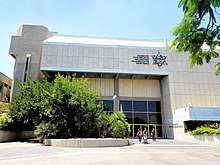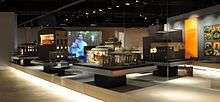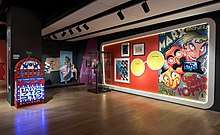The Museum of the Jewish People at Beit Hatfutsot



The Museum of the Jewish People at Beit Hatfutsot[1] is located in Tel Aviv, Israel, at the center of the Tel Aviv University campus in Ramat Aviv.
The Museum of the Jewish People at Beit Hatfutsot is a global institution that tells the ongoing story of the Jewish people, intended for people of all faiths. Through its educational programming, the institution works to connect Jewish people to their roots and strengthen their personal and collective Jewish identity. The museum presents a pluralistic narrative of Jewish culture, faith, purpose and deed as seen through the lens of Jewish history and current experience today.
Formerly the Nahum Goldmann Museum of the Jewish Diaspora[2] (Hebrew: בית התפוצות, "The Diaspora House"), the museum launched a large-scale renewal in 2016, adding a new wing with rotating temporary exhibitions, the Alfred H. Moses and Family Synagogue Hall featuring synagogue scale models, and Heroes - Trailblazers of the Jewish People, a children's interactive exhibition. Museum renovations will culminate with the opening of a new permanent core exhibition in early 2020.[3] It is a center for Jewish discourse, engagement, education[4] and research, encompassing a pluralistic and comprehensive worldview.
Governance
Irina Nevzlin serves as the current Chair of the Board of Directors and is the President of the NADAV Foundation. Senator Joseph I. Lieberman (Honorary Chair), Ambassador Alfred H. Moses (Co-Chair) and Major-General (Ret.) Eitan Ben-Eliyahu (Co-Chair) serve on the Board of Governors.
History
In 1959, the World Jewish Congress decided to build a museum that would serve both as an educational and cultural center for world Jewry.[5] The institute in Israel was named in honor of Dr. Nahum Goldmann, founder and president of the World Jewish Congress.
Abba Kovner, one of the founders of Beit Hatfutsot, proposed the original concept of the museum's permanent core exhibition.[6] It was based on a thematic principle, representing Jewish history and continuity, according to six themes, or "gates" that portray central aspects of Jewish life: family, community, faith, culture, existence and return.[7] Among the founders of the museum, Jeshajahu Weinberg served as the museum's first director from 1978 to 1984[6] and Dr. Meyer Weisgal was its first President.
Beit Hatfutsot opened on May 15, 1978. From the start, it was regarded as one of the most technologically advanced museums of its time.[5] Its exhibitions were based on reconstructions and sets, using modern audiovisual and state-of-the-art computer technology to explore topics and themes throughout the museum. This methodology provided that a museum could be an effective storyteller. Its designers broke with the universally accepted tradition that museums exist first in order to acquire, care for and display objects from the past.[8]
Government budget cuts and a decline in Israeli tourism triggered a budget crisis at the museum. A number of public representatives devoted themselves to saving the museum, among them Shlomo Lahat, former mayor of Tel Aviv, and Ariel Sharon, former prime minister.[9] In 2005, the Israeli Knesset passed the "Beit Hatfutsot Law" that defines Beit Hatfutsot as "the National Center for Jewish Communities in Israel and around the world".[10][3] A recovery plan was enacted with two partners: the Israeli Government and donor Leonid Nevzlin (NADAV Foundation), with a grant from the Claims Conference.[11]
Exhibitions, programs, education and research
The Museum of the Jewish People at Beit Hatfutsot allows visitors to learn more about the Jewish experience through a number of access points. Onsite, the museum offers a permanent exhibition, children's gallery, rotating schedule of temporary exhibitions and related programs, conferences and workshops. The museum's databases house searchable archives of photos, films, music, genealogy (family trees) and family names, all related to the Jews and Jewish history. Compiled over almost four decades, these databases are now fully digitized and available both onsite and online. The museum also offers formal and informal educational activities for teachers and students, at the museum and/or for use in classrooms around the world.[3]
Exhibitions
The thematic center of the Museum of the Jewish People at Beit Hatfutsot is its exhibitions; the permanent core exhibition and the new wing which includes five galleries. The two permanent installations in the new wing include The Alfred H. Moses and Family Synagogue Hall and the Heroes children's gallery. There are also three temporary, rotating exhibition galleries in the new wing. The exhibitions all focus on issues of Jewish identity and pluralism.[12]
The Alfred H. Moses and Family Synagogue Hall (permanent)
The Synagogue Hall features the exhibition Hallelujah! Assemble, Pray, Study – Synagogues Past and Present. This exhibition presents 21 scale synaogue models representing various communities and Jewish ritual relating to the synagogue: social gatherings, study, creativity and prayer, as well as weddings, Bar/Bat Mitzvahs, fundraising, charity, etc. Alongside each model is an original ritual artifact, either from the synagogue or its respective community.
Heroes – Trailblazers of the Jewish People (permanent)
This is an interactive exhibition experience designed for children ages 6–12 and their families. Visitors will meet different types of Jewish heroes from throughout history including scientists, intellectuals, leaders, revolutionaries, cultural figures, athletes and more – men and women with unique talents.
Let There Be Laughter – Jewish Humor Around the World (temporary)
This exhibition looks at the origins of Jewish humor and the contributions of Jews to the rise of this global industry.
Workshops and lectures
Programming for the general public includes programs related to the exhibitions and also lectures featuring specialists in Jewish history and culture, workshops, film screenings and more.
Education
The Koret International School for Jewish Peoplehood Studies (ISJPS) develops the discipline of Jewish Peoplehood studies and disseminates formal educational curricula and teaching guides for use in Israel and abroad. The school also creates workshops geared towards educational groups visiting Israel on short and long-term programs.[3]
Open databases
The Oster Visual Documentation Center houses collections of ~500,000 photos of Jewish life, as well as over 1,000 films. This collection includes rare documentary films and amateur video footage dating back to the 1920s, as well as contemporary films produced in Israel and abroad.
The Douglas E. Goldman Jewish Genealogy Center contains thousands of Jewish family trees with more than 5,000,000 individuals currently registered. This database enables users to trace family roots and build family trees for future generations.
The Feher Jewish Music Center is a collection of thousands of recordings of Jewish music from various communities including traditional songs, prayers, complete albums and information about Jewish musicians, composers and poets.
The Memi De-Shalit Database of Jewish Family Names is a database containing over 20,000 short interpretations of Jewish family names including their linguistic origin, history and derivations.
The Jewish Communities Database contains history, demography and geography of thousands of Jewish communities worldwide.
Personalities is a database containing thousands of biographies of renowned and noteworthy Jewish individuals.[3]
See also
References
- ↑ "Museum of the Diaspora Changing its Name and Focus/". J. The Jewish News of Northern California. March 5, 2010.
- ↑ Raider, edited by Mark A. (2010). Nahum Goldmann: Statesman without a State. Albany, N.Y.: SUNY Press. ISBN 978-1-4384-2500-9.
- 1 2 3 4 5 "Beit Hatfutsot - The Museum of The Jewish People in Tel Aviv".
- ↑ "Koret Foundation Gives $10 million to Tel Aviv's Museum of the Jewish People". Jewish Telegraphic Agency. January 18, 2017.
- 1 2 Scrieberg, David (June 15, 1979). "Beth Hadtefutsoth:2500 Years of Jewish History Under One Roof". Israel Digest.
- 1 2 Wigoder, Geoffrey (1988). Beth Hatefutsoth - The First Ten Years - The Nathan Goldmann Museum of the Jewish Diaspora. Nahum Goldmann Museum.
- ↑ Raider, edited by Mark A. (2010). Nahum Goldmann : Statesman without a State. Albany, N.Y.: SUNY Press. ISBN 978-1-4384-2500-9.
- ↑ Hudson, Kenneth (1987). Museums of influence (Reprint. ed.). Cambridge [Cambridgeshire]: Cambridge University Press. ISBN 978-0521305341.
- ↑ "Second Life for Beit Hatfutsot Museum of the Jewish People".
- ↑ Anath Hartmann (November 12, 2009). "Bringing the Story of Jewish Life Back to Life". Jewish Telegraphic Agency.
- ↑ Herb Keinon (September 4, 2011). "Cabinet Approves NIS 24m Beit Hatfutsot Development Plan". The Jerusalem Post.
- ↑ Leni Reiss (February 24, 2017). "Recently Renovated Museum of the Jewish People Strengthens Cultural Ties". Arizona Jewish Life.
External links
| Wikimedia Commons has media related to Beyt ha-Tefutsoth. |
- Official website
- "The Museum of the Jewish People at Beit Hatfutsot". TripAdvisor.
- "Tracing History in Israel". The New York Times
Coordinates: 32°06′49.72″N 34°48′18.94″E / 32.1138111°N 34.8052611°E